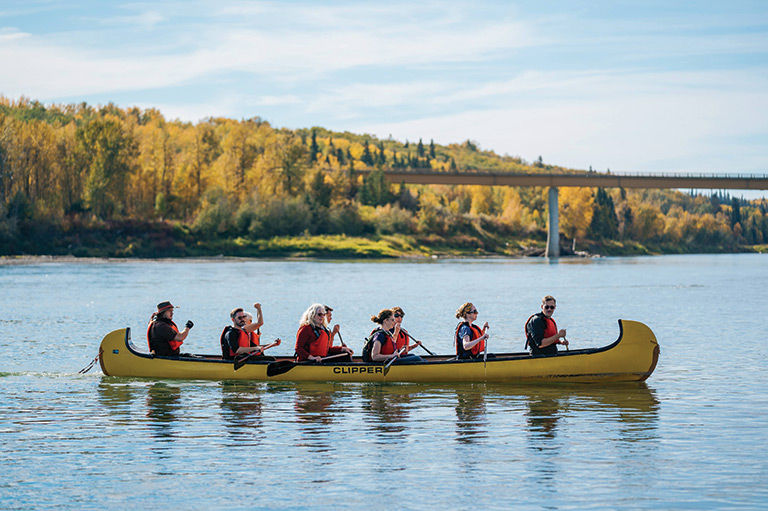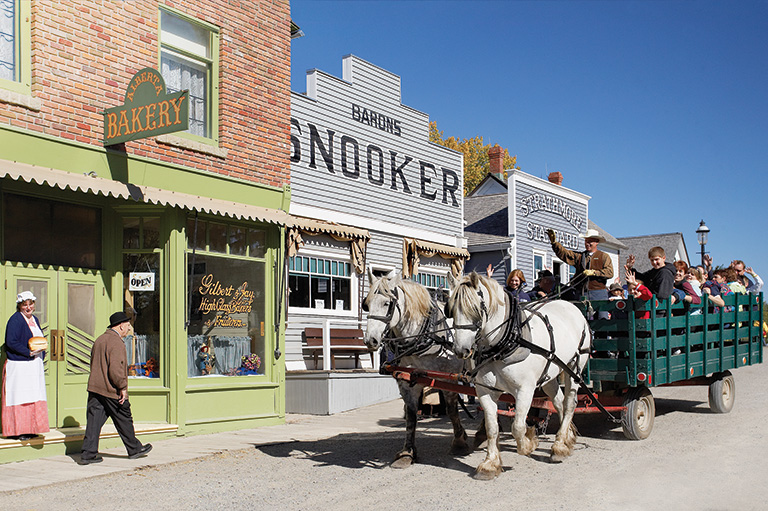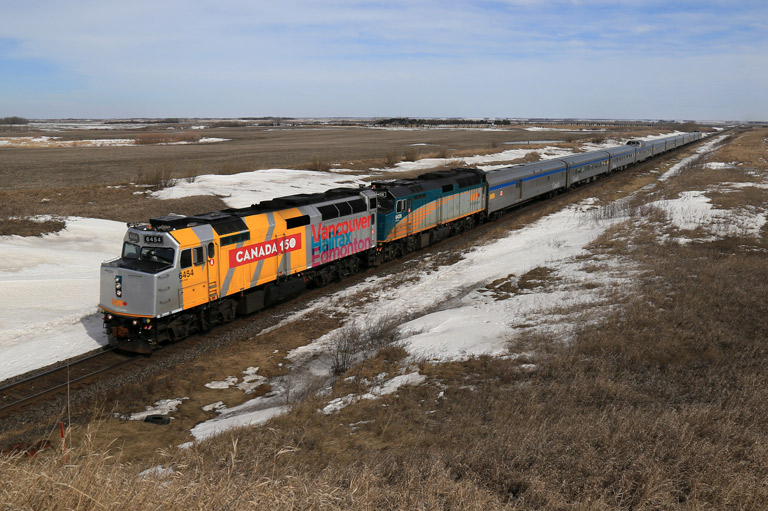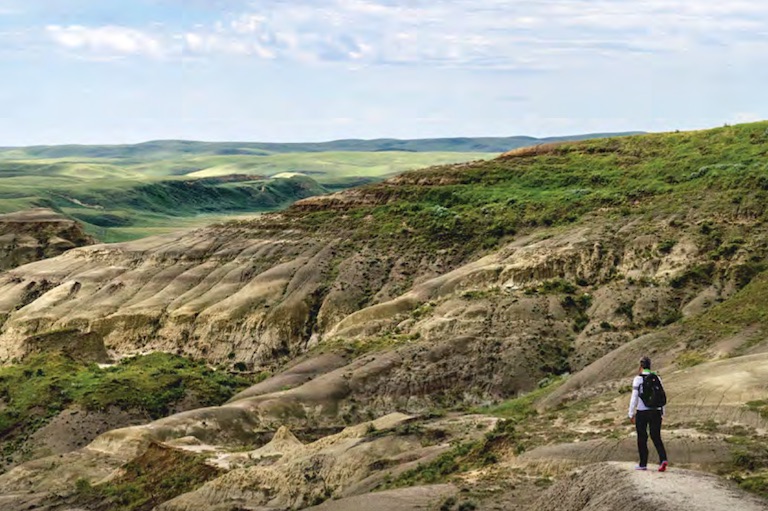Métis Magic

Before paddling down the North Saskatchewan River in a giant communal canoe, we gather on the shore to practise singing in unison. “J’entends le moulin, tique, tique, taque,” we sing, first slowly, then at increasingly faster paces. “J’entends le moulin, tique, tique, taque.”
We aren’t just belting out a French-Canadian folk song about a mill wheel, we’re imagining how it felt to be voyageurs transporting furs and trade goods for the Hudson’s Bay Company. Repetitive verses taught men from Scotland, England and France to work together.
With 7 uniquely curated newsletters to choose from, we have something for everyone.
The voyageurs measured distance in song and mapped the rivers with their voices, artist Danielle LaRose explains as we paddle between Métis Crossing, about 90 minutes northeast of Edmonton, and Victoria Settlement Provincial Historic Site. Those “beautiful, hard-working men with their beautiful voices” impressed the First Nations women they passed, she says.
“I always consider our waterways to be the matchmakers of the Métis Nation because if it wasn’t for those rivers and those waterways, our European grandfathers would never have met our First Nations grandmothers,” says LaRose. “The river is still the one that’s bringing us together, and she’s still the one that’s holding space for us to reconnect, learn from one another and share our stories. She’s got lots of gifts to give us.”
The gift that autumn afternoon — on what’s now a Canadian Heritage River — is insight into how the Métis helped shape Canada.
I had made the drive northeast from Edmonton to see why Métis Crossing is Alberta’s premier destination for Métis culture, history and adventure. Owned by the Métis Nation of Alberta, it sits on 278 hectares of historical land within Victoria District National Historic Site.

Advertisement
A trading spot for First Nations people for 8,000 years, this land evolved into river lots homesteaded by the original Métis settlers from Red River, Man., in the 1860s. Long, narrow strips of land ran perpendicular to rivers so farmers had water access and wooded lots.
Métis Crossing now uses the land as a way to share the story of the Métis people — past, present and future — through cultural experiences.
“We are children of the fur trade,” says Métis Crossing CEO Juanita Marois. “We do not claim to be here from time immemorial, like our First Nations ancestors do, but we claim to be a nation of people on this land before Canada was a nation.”
Canada recognizes the Métis, First Nations and Inuit as distinct Indigenous Peoples. While 550,000 people self-identify as Métis, some are simply of mixed ancestry and can’t prove they descended from voyageurs. The Métis Nation of Alberta has 54,000 registered citizens.
Métis Crossing showcases a Red River cart in its cultural heritage gathering centre. “It was really cool technology for the time,” says Marois, “the first amphibious vehicle.” Made of wood with removable wheels and no metal parts, the carts could float across rivers.
Save as much as 40% off the cover price! 4 issues per year as low as $29.95. Available in print and digital. Tariff-exempt!
Next to the centre is a boutique lodge designed by a Métis architect that hints at fur trade-era river-lot homes and features Métis quilts. Sky-watching domes let people take in the aurora borealis and constellations while learning how the Métis used the sky as a clock, calendar and navigation tool. A restaurant serves Indigenous-inspired meals, such as Saskatoon-berry lemonade, wild rice soup, bison burgers and a Métis Grub Sandwich featuring fried bologna on bannock. “We try to engage your head, your heart, your hands and your hunger,” explains Marois.
Daily seasonal experiences reflect Métis life on the land. That might mean snowshoeing to a trapline, taking archery lessons to understand hunting, hearing about the forest’s bounty, learning beadwork or doing the “Paddle into the Past” canoe journey.
“This was never meant to be a museum where you looked at old things behind glass and you read plaques,” says Marois. “This is all about coming to experience Métis culture — to interact with people, to get onto the water to have a paddle into the past, to interact with these amazing bison.”
Bison are called bufloo in Michif, the Métis language. They once roamed these hills when the Métis people gathered for seasonal hunts. Now they’re back in a 130-hectare wildlife park created with Ukrainian-Canadian rancher Len Hrehorets.
When I have a return visit in winter, I take Métis Crossing’s signature wildlife tour. Knowledge Holder Lilyrose Meyers drives me through five paddocks to see plains and wood bison, elk and Percheron horses.
Meyers greets the animals like relatives and conveys her love of the land. “It recharges you,” she says. “Métis Crossing is a place of learning. It’s for all of us.”

IF YOU GO
GETTING THERE: Métis Crossing is 90 minutes northeast of Edmonton and 10 minutes south of Smoky Lake. It’s open year-round for day trips and overnight stays at three price points — camping, a boutique lodge and luxury sky-watching domes.
EAT AND DRINK: Métis Crossing serves Indigenous-inspired cuisine at its Bistro at the Lodge. Try bannock with seasonal jam, wild rice soup and bison burgers.
EXPLORE: Take the route from Edmonton that passes by Elk Island National Park, Canada’s first wildlife refuge and only fully enclosed national park. Founded in 1906 as an elk preserve, the park is now known for its conservation herd of 400 plains bison and 300 wood bison.
We hope you’ll help us continue to share fascinating stories about Canada’s past by making a donation to Canada’s History Society today.
We highlight our nation’s diverse past by telling stories that illuminate the people, places, and events that unite us as Canadians, and by making those stories accessible to everyone through our free online content.
We are a registered charity that depends on contributions from readers like you to share inspiring and informative stories with students and citizens of all ages — award-winning stories written by Canada’s top historians, authors, journalists, and history enthusiasts.
Any amount helps, or better yet, start a monthly donation today. Your support makes all the difference. Thank you!
Themes associated with this article
Advertisement









